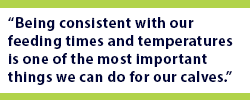
Virtual Farm Tour: Cam-Cal-Kar Dairy Farm
Cam-Cal-Kar Dairy Farm raises big calves by focusing on basics
If protocols are simple, they are more likely to be done correctly. That’s the philosophy for the calf program at Cam-Cal-Kar Dairy Farm in Browntown, Wisconsin. The farm is owned and operated by Craig and Katharine Edler. Their daughter, Cali Schliem, manages the calf and heifer program.
The Edler family built its 125-pen calf barn in 2014. Prior to that, the calves were raised in hutches, a calf barn and an old dairy barn. The two-row calf barn has a positive pressure ventilation tube system. Individual pens are spaced away from the sidewalls to prevent drafts on the calves. Each pen has a drain in the concrete to help keep bedding dry.
Newborn care
The farm uses just-in-time calving. Colostrum is harvested and fed to the newborn within the first two hours of life, ideally during the first hour. Maternal colostrum is offered by bottle first and, if the calf doesn’t drink, colostrum is tubed. Maternal milk from the second milking is given to newborns as their second meal. The newborn calves are placed in hutches in the maternity area. Once dry, they are moved to individual pens in the calf barn.
High plane of nutrition
Schliem feeds pasteurized milk twice daily to approximately 100 preweaned calves. They start on bottles and are switched to buckets as soon as possible. They are fed 3 quarts at first and ramp up to 2 gallons per feeding by three weeks of age. Calves are also fed BSF calf starter with 22% protein, according to their intakes.
The pasteurizer is located by the milking parlor, which is at a different site than the calf barn. Once milk is pasteurized, it is held at 110 degrees F. A tank mounted on the back of a truck is used to transport the warm milk to the calf barn to be fed immediately. The barn is designed with a milk house and wash bay in the center of the barn. Schliem or another member of her team parks the truck in the wash bay, and the feeding hose is long enough to reach the furthest calves. Schliem marks the milk pails so calves are fed a consistent amount of milk every time. A clean-in-place system is used to clean the milk tank and hoses.
“Being consistent with our feeding times and temperatures is one of the most important things we can do for our calves,” Schliem said.
 Calves begin the weaning process at 60 days of age by receiving one feeding of milk per day. After one week, milk is eliminated, but the calf will stay in its pen for at least one more week. Schliem said she does not see issues during the transition phase as long as weaned calves stay in their individual pens for that extra week.
Calves begin the weaning process at 60 days of age by receiving one feeding of milk per day. After one week, milk is eliminated, but the calf will stay in its pen for at least one more week. Schliem said she does not see issues during the transition phase as long as weaned calves stay in their individual pens for that extra week.
Weaned heifers are then moved to a heifer barn and placed into groups of eight calves. At this point, they switch to a starter grain with 18% protein. They will also be introduced to free-choice hay shortly after they move. At five months, they’ll start on a heifer TMR.
Value in simplicity
“We keep it pretty simple around here,” Schliem said, explaining how the simplicity of the farm’s calf protocols helps her and two other calf team members provide consistent care to the animals. She added that she puts a lot of focus on dry cow and first-calf heifer health. She said this, combined with the calves’ high plane of nutrition and a solid vaccination program, has led to larger, stronger calves at weaning with fewer disease challenges along the way.
| Category: |
Farm tours Starting Strong - Calf Care |

